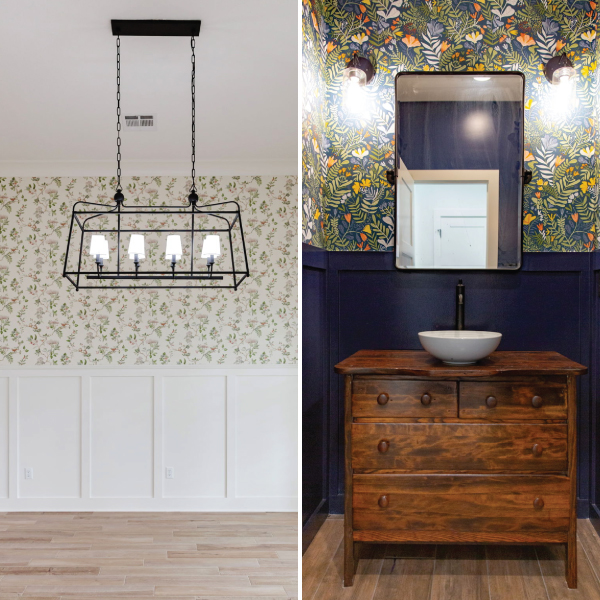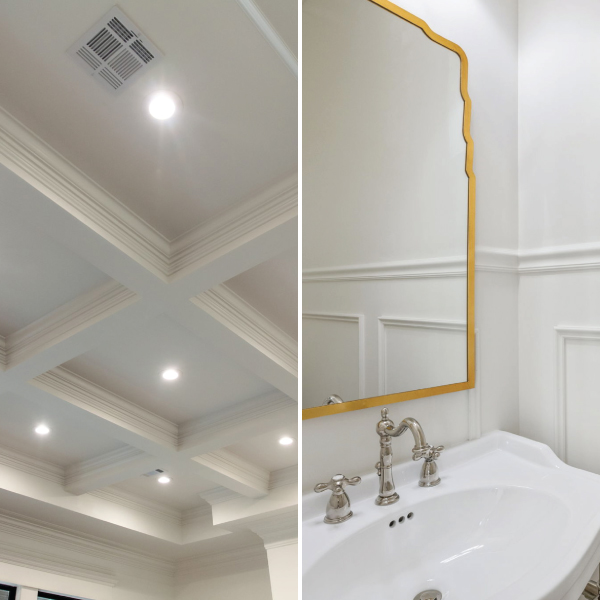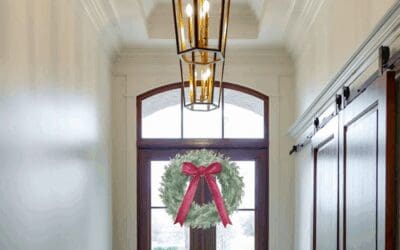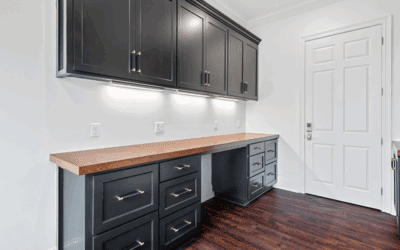Trim might seem like one of the smallest parts of a home, but its effect is big. The right trim can make a room feel taller, more elegant, more modern…or warm, cozy, and classic. In new construction, choosing the right trim style early matters just as much as picking flooring or cabinets. It ties everything together! We’ll be exploring some of the trim trends homeowners are embracing now, what makes them special, and which ones tend to work best here in Southwest Louisiana.
What “Trim Style” Really Means
When we talk about trim, we mean things like baseboards (where wall meets floor), crown molding (wall meets ceiling), door and window casings, sometimes chair rails or wainscoting, and decorative paneling or moldings. The style of trim involves profile (how simple or detailed it is), size (height and width), material (type of wood, engineered composites, etc.), finish (painted, stained, natural), and how it’s used in spaces (accent, continuous detail, minimalist, ornate, etc.).

Trends to Watch
Clean, Simple Profiles. Many homeowners right now are leaning toward trim with smooth, flat, or gently curved profiles rather than highly ornate or heavily carved moldings. This trend matches well with modern, transitional, or contemporary interior styles. Simple baseboards (maybe 4-5 inches tall), minimal casings, and crisp lines are easier to clean, less fussy, and pair well with open floor plans. They feel fresh without being trendy in a way that will quickly feel dated.
Taller Baseboards & Scaled Trim. On the other hand, there’s a movement toward more “presence” in trim. Taller baseboards (6-8 inches or more) add a sense of formality, elegance, and proportion, especially in rooms with higher ceilings. Window and door casings are being scaled up, too, so they don’t feel lost in the wall. If your ceilings are 10 ft or more, going with more substantial trim gives balance and proportion, elevating the overall look.
Contrasting Trim Finishes. Trim doesn’t always have to blend in. Something that is becoming more and more frequent is homeowners using trim as an accent by choosing finishes that contrast with walls: for example, white or off-white trim against darker or richer wall colors, or even bold colored doors/windows with matching casing. This adds visual layers and character without overcomplicating the architecture.
Mixed Materials & Durability. With heat, humidity, rain, and occasional storms, what the trim is made of matters almost as much as how it looks. Manufactured woods or engineered composites that resist swelling, warping, or rot are being paired with traditional woods where it makes sense. Stained wood trims inside with painted casing outside, or materials that can handle moisture without maintenance, are growing in popularity.
Decorative Panels, Wainscoting, and Board & Batten. For accent walls, hallways, entryways, or staircases, homeowners are again embracing paneling details. Wainscoting (panels on the lower part of walls, often topped with a chair rail) or board & batten details bring texture and dimension, especially in rooms that might otherwise feel boxy. Even a partial accent wall or a hallway with panel detail can add charm without huge cost.
Transitional Trim Styles. Trim styles that bridge traditional and modern are strong: profiles that have just a touch of detail, perhaps a subtle curve or bevel, but clean overall. These “transitional” styles offer the best of both worlds: elegance without heavy ornament, warmth without being cluttered, which tends to suit many of the homes being built now.
What Works Best in Southwest Louisiana
Because of our climate and building challenges, some of these trim trends are more practical than others. Here are considerations to keep in mind:
- Moisture and humidity: high moisture can cause certain woods to warp or rot. Choosing engineered or treated materials (especially in bathrooms, exteriors, or near openings) helps avoid long-term issues.
- Maintenance: simpler profiles with fewer nooks and grooves are easier to keep clean, less likely to trap dust, and less prone to peeling paint or swelling. If a trim style requires more upkeep (frequently repainting, touching up), you’ll want to factor that into the long-term cost.
- Local architecture: many homes in Southwest Louisiana blend influences, including traditional southern, coastal, modern ranch, etc. Choosing a trim style that complements the overall home style matters. For example, a colonial-style home might feel more “right” with more traditional crown molding and substantial baseboards; a modern or coastal-style house would look better with cleaner, flatter styles.
- Scale and proportion: ceiling heights, room width, and door size all influence how trim reads. In rooms with lower ceilings, very tall baseboards and heavy crown molding can feel overwhelming. In larger or more open rooms (great rooms, foyers), you can go bolder.

Tips for Choosing Trim in Your New Build
- Start when you’re selecting finishes and don’t wait until after framing or drywall. Trim choices influence costs (labor & material) and impact how everything else looks (floors, cabinetry, windows).
- Gather style inspiration. Look at local homes or even recent VT Contracting projects: photos, showrooms, social media. Knowing what profile, height, material, and color combinations you like helps make design decisions smoother.
- Match or balance with other millwork and finishes. If you have stained cabinetry, exposed beams, or special ceiling detailing, consider how those tones and textures play with your trim. Trim should coordinate, not compete.
- Think long term: what are you willing to maintain? How will sunlight, humidity, and pests affect the materials you choose? What about paint durability or finish options? Budget a little extra for things that will save headaches later.
Final Thoughts
Trim is often one of the last “looks” homeowners notice…but one of the first things they feel in terms of quality. Whether you go clean and modern, classic and bold, or somewhere in between, trim helps unify your home. It frames the details, guides your eye, and gives that finished, polished feeling. At VT Contracting, we combine style with smart material choices that make the difference between something that looks good initially and something that looks great year after year.
If you’re working through your new home’s trim options, we can help walk you through profiles, material samples, and what works best for your style, your budget, and your climate. Contact VT Contracting today, and let’s make the finishing touches as strong as the foundation of your home.



